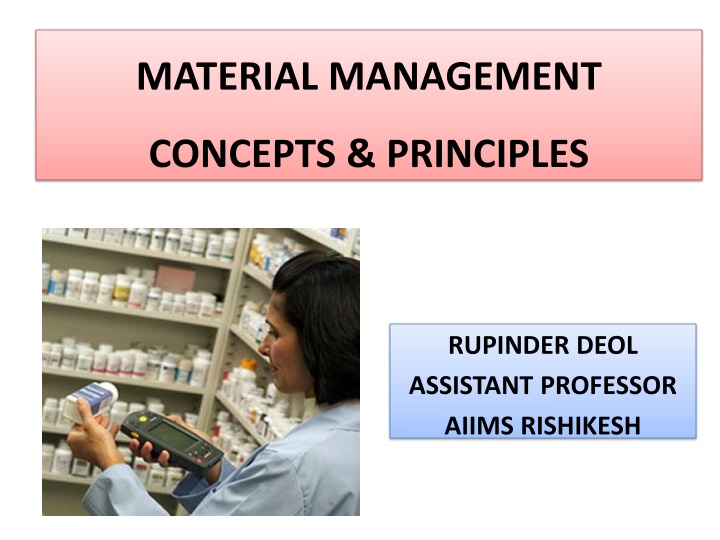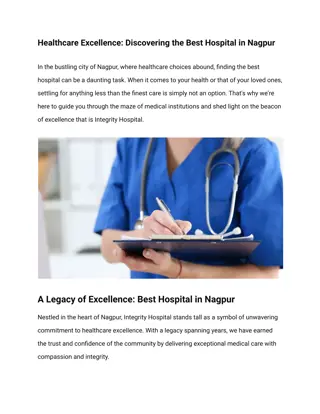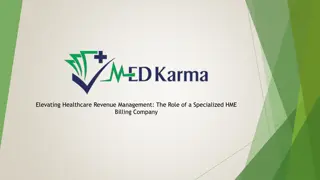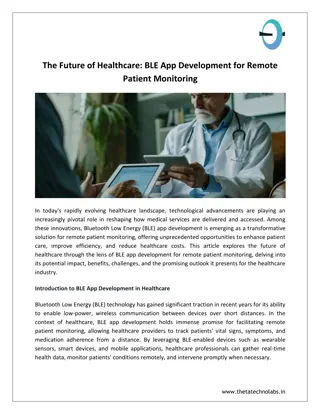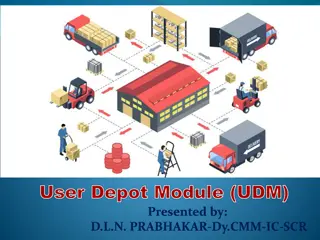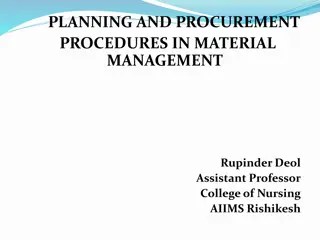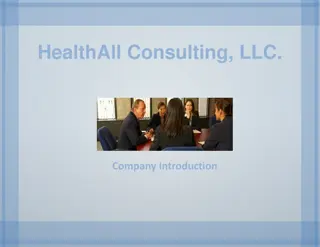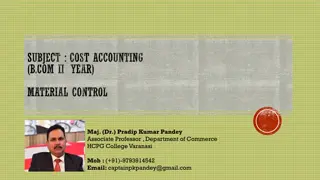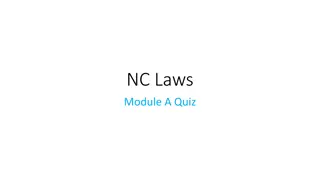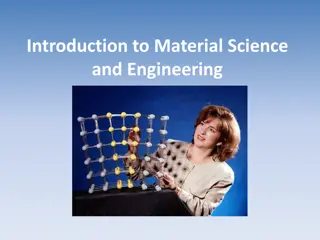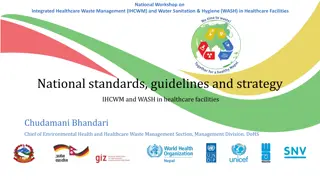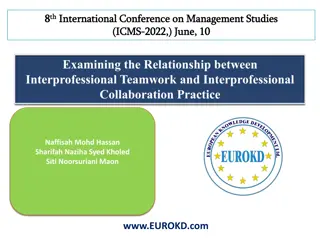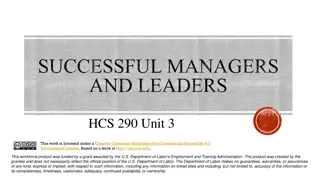Material Management Concepts in Healthcare
Material management in the healthcare system involves providing essential drugs, supplies, and equipment for delivering health services. This includes a wide range of materials such as drugs, medicines, medical supplies, equipment, and facilities. Effective management ensures the right quality materials are supplied to meet the needs of healthcare providers and patients, optimizing resources and enhancing service delivery.
Download Presentation

Please find below an Image/Link to download the presentation.
The content on the website is provided AS IS for your information and personal use only. It may not be sold, licensed, or shared on other websites without obtaining consent from the author.If you encounter any issues during the download, it is possible that the publisher has removed the file from their server.
You are allowed to download the files provided on this website for personal or commercial use, subject to the condition that they are used lawfully. All files are the property of their respective owners.
The content on the website is provided AS IS for your information and personal use only. It may not be sold, licensed, or shared on other websites without obtaining consent from the author.
E N D
Presentation Transcript
MATERIAL MANAGEMENT CONCEPTS & PRINCIPLES RUPINDER DEOL ASSISTANT PROFESSOR AIIMS RISHIKESH
INTRODUCTION The material management in the health care system is concerned with providing the drugs, supplies and equipment needed by health personnel to deliver health services. About 40 percent of the funds in the health care system are used up for providing materials. It is of great importance that materials of right quality are supplied to the consumers
DEFINITION OF MATERIAL Webster defines the word materials as relating to the production & distribution of economics, goods & social relationships of owners & labourers . Housely states, materials should be used universally to refer to hospital supplies & equipments. Materials thus may be defined as equipment, apparatus & supplies procured, stocked & utilised by an organisation
TYPES OF MATERIALS DRUGS & MEDICINES- Including anaesthetic agents, vaccines & drugs required for specific purposes. SUPPLIES- Required for diagnosing & treating ailments such as cotton, bandages, gauze, dressing materials, syringes, needles, forceps, splints, plasters, trays, bottles, linen, utensils, various chemicals & reagents/ ready kits for investigations, x-ray plates, radiodiagnostic materials, drugs used in radiology. Supplies may also include items of linen like drawsheets, bed cover, mattress, pillows, masks, aprons, surgical gowns, gloves, etc. or soaps, detergents, antiseptics, broom, candles, match boxes, needles, stationary items, slippers for OT, etc.
TYPES OF MATERIALS contd.. EQUIPMENTS & INSTRUMENTS- Office furniture, refrigerators, AC, trolley, tables, screen, examination tables, IV stands, bedside lockers, sterilizers, X-ray machines, ABG analyzers, pulse oximeter, defibrillators, cardiac monitor, endoscope, oxygen & nitrous gas cylinders, washing machines, incinerators, etc. FACILITIES- Include non movable materials used for long time compared to equipments which have limited life span e.g. buildings, toilets, lifts, water tanks, pumps, kitchen, cooking facilities telephone, etc.
MANAGEMENT Management may be defined as the art of securing maximum results with a minimum of efforts so as to secure maximum prosperity and happiness for both employer and employee and give the public the best possible service . John Mee
MATERIAL MANAGEMENT Management means bringing together the available resources so as to achieve a specific objective. Management is the function responsible for the coordination of planning, sourcing, purchasing, storing & controlling materials in an optimum manner so as to provide a predecided service at minimum cost. Housely defined material management as, The management & control of goods, services & equipment from acquisition to disposition . Judith A Mnarandole defined material management as, The management & control of medical, surgical, clerical, interdepartment services & equipment from acquisition on floor to disposition .
MATERIAL MANAGEMENT Material management is a scientific technique, concerned with planning, organizing and controlling the flow of materials from their initial purchase through internal operations to the service point through distribution. Material management is the integrated functioning of an organisation dealing with supply of materials & allied activities in order to achieve the maximum coordination & optimum expenditure on materials.
CONCEPTS OF MATERIAL MANAGEMENT Material management is concerned with providing the drugs, supplies and equipment needed by health personnel to deliver health services. The right drugs, supplies and equipment must be at the right place, at the right time and in the right quantity in order that health personnel deliver health services. Without proper material, health personnel cannot work effectively, they feel frustrated and the community lacks confidence in the health services and unless appropriate materials are provided in proper time and is required quantity, productivity of personnel will not be upto expectation.
INTEGRATED MATERIAL MANAGEMENT Close coordination of all departments which are concerned with utilisation of materials. If some of functions are to be separately handled, normally a conflict of interest occurs & there is bound to be an increase in materials costs. In an integrated set up, materials manager is responsible for all such inter- related functions & is in a position to exercise control & coordination with a view to ensure proper balance of conflicting objectives of individual functions. Integrated material management concept has recently gained greater importance in India. Although organisations may not be adopting it in totality, there is a definite tendency to move towards an integrated approach.
NEED FOR INTEGRATED CONCEPT The major functions served by materials management include Material Planning, Purchasing, Receiving, Stores, Inventory Control, Scrap and Surplus Disposal. If handled separately it may lead to a conflict of interest. Eg: if purchasing is handled separately they may over purchase to avail discounts without considering the expenditure for stores and inventory control, which will result in over expenditure.
ADVANTAGES OF INTEGRATED MATERIAL MANAGEMENT BETTER ACCOUNTABILITY- Centralisation of authority & responsibility for all aspects of materials functions ensures specific accountability. BETTER COORDINATION- Coordination of various functions of material management is facilitated. BETTER PERFORMANCE- As all inter-related functions are integrated organisationally, an effective communication & enhanced performance is a natural sequelae. ADAPTABILITY TO ELECTRONIC DATA PROCESSING (EDP)- All information with regard to materials functions is centralised. This facilitates collection, collation & analysis of data leading to better decisions. Advanced & efficient EDP systems can be economically introduced under integrated set up. MISCELLANEOUS ADVANTAGES- Team spirit is inculcated resulting in coordination & cooperation. Opportunities of growth & development are better in integrated set up.
CORPORATE POLICY AND MM General Corporate Policy Are laid out to achieve the corporate goals the organization has set for itself Policy must be laid out with regards to source selection, quotations, negotiations, price, quality etc. Quality Requirements Quality requirements shall be laid out precisely and steps must be taken to ensure that these are met. If a failure to meet the QR is found steps need be defined to achieve the QR by alternate means. Quantity Requirements Clear policies shall be laid out as to what procurement procedures need be taken according to the quantum of purchase.
ORGANISATION AND CONTROL Relationship of Material Management with regard to other departments shall be finalized to ensure adequate supply and effective utilization of resources. Organizing Material Management Organization based on Commodities items are classified according to their nature such as raw materials used, spares, imported items etc. Organization based on Location based on the spread of locations where the materials are to be distributed a centralized or distributed MM organization shall be put in place. Organization based on Function here the MM department is structured based on various functions like Purchasing, Stores, Transport etc.
MATERIALS PLANNING AND BUDGETING Importance Planning for materials and working out a realistic budget serves as a control device. Techniques Bill of Material Explosion to forecast of demand of end products and based on the demand arriving at the requirements of various materials. Past Consumption Analysis used for items which are consumed on a regular basis and items for which BoM cannot be prepared. Past consumption is analyzed and projection for the future is made
BUDGETING ABC Analysis Always Better Control or Alphabetical approach tries to anaLyse the distribution of any material by money value of importance in order to determine its priority. Based on the money value of importance the items can be classified into A, B and C class items. This approach helps the manger to have selective control and focus his attention on a few items when he is confronted by a large variety of items.
SOURCE SELECTION Why Source Selection Source Selection has to be kept as a corporate policy Helps in bringing about a fair competition among the suppliers and supply failures are kept at a minimum. Stages of Source Selection Searching Selection Negotiation and Trial Orders Rating based on performance Quality
OBJECTIVES OF MATERIAL MANAGEMENT To reduce cost of material Ensure a good support with suppliers(vendors) Effective and efficient handling of materials at all stages and in all sections. In other hand objectives of material management Low purchase price Maintaining continuous supply Maintaining quality Cordial relationship with supplier Low pay roll cost Development of vendors
OBJECTIVES OF MATERIAL MANAGEMENT Good record Low storage cost Favorable reciprocal relation New material & products Standardization Product improvement Interdepartmental harmony Economic forecasting.
AIM OF MATERIAL MANAGEMENT To get The right quality Right quantity of supplies At the right time At the right place For the right cost.
PURPOSE OF MATERIAL MANAGEMENT To gain economy in purchasing To satisfy the demand during period of replenishment To carry reserve stock to avoid stock out. To stabilize fluctuations in consumption To provide reasonable level of client services Increase efficiency of health care systems. Develop knowledge and skills of health care Provide materials in required quantity and quality as when required.
FUNCTIONS OF MATERIAL MANAGEMENT Material planning & budgeting Purchasing Inventory control Cost reduction Value analysis Receiving & inspection Stocking & distribution Disposal.
ELEMENTS OF MATERIAL MANAGEMENT Material planning Standardization Purchasing Production control Receiving & warehousing Transportation Store keeping Material handling Inventory control Disposal scarp Value analysis
BASIC PRINCIPLES OF MATERIAL MANAGEMENT Effective management and supervision; it deals on material functions of; planning, organizing, staffing, controlling, report and budgeting. Sound purchasing method Skillful and hard poised negotiation Effective purchase system Should be simple Simple inventory control program.
MATERIAL MANAGEMENT IN HEALTH CARE INSTITUTIONS Material management is relatively a new concept in health care field. Modern techniques of efficient material management were developed in US of America during & after 2ndWorld war which helped industrial developed to make spectacular progress in improving their productivity. Term was unknown in India till 60 s. Terms such as purchasing, store keeping, transportation, etc. were in use in country which in a vague manner represented the functions covered by modern material management. Many hospitals have started adopting this management concept in whole or in part to accomplish the objectives of providing efficient patient care due to increasing awareness of importance of material management in last few years.
CONCLUSION Material management is an important management tool which will be very useful in getting the right quality & right quantity of supplies at right time, having good inventory control & adopting sound methods of condemnation & disposal will improve the efficiency of the organization & also make the working atmosphere healthy any type of organization, whether it is Private, Government ,Small organization, Big organization and Household. Even a common man must know the basics of material management so that he can get the best of the available resources and make it a habit to adopt the principles of material management in all our daily activities
BIBLIOGRAPHY Gupta S, Kant S. Hospital stores management. An integrated approach. 1sted. New Delhi. Jaypee brothers medical publishers (P) Ltd. 2000.p.1-9,60-1,44- 6,58-90. Chandorkar AG. Hospital administration & planning.1sted. Hyderabad. Paras medical publishers.2004. p.181-215. Barrett J. Ward management & teaching. 2nded. New Delhi. The English book store. 1967. Kunders G D, Gopinath S, Katakam A. Hospitals planning, design & management. 1sted. New Delhi. Tata Mc Graw Hill. 1998.p.282-8. P. Gopalakrishnan M. Sundaresan, Materials management - an integrated approach
